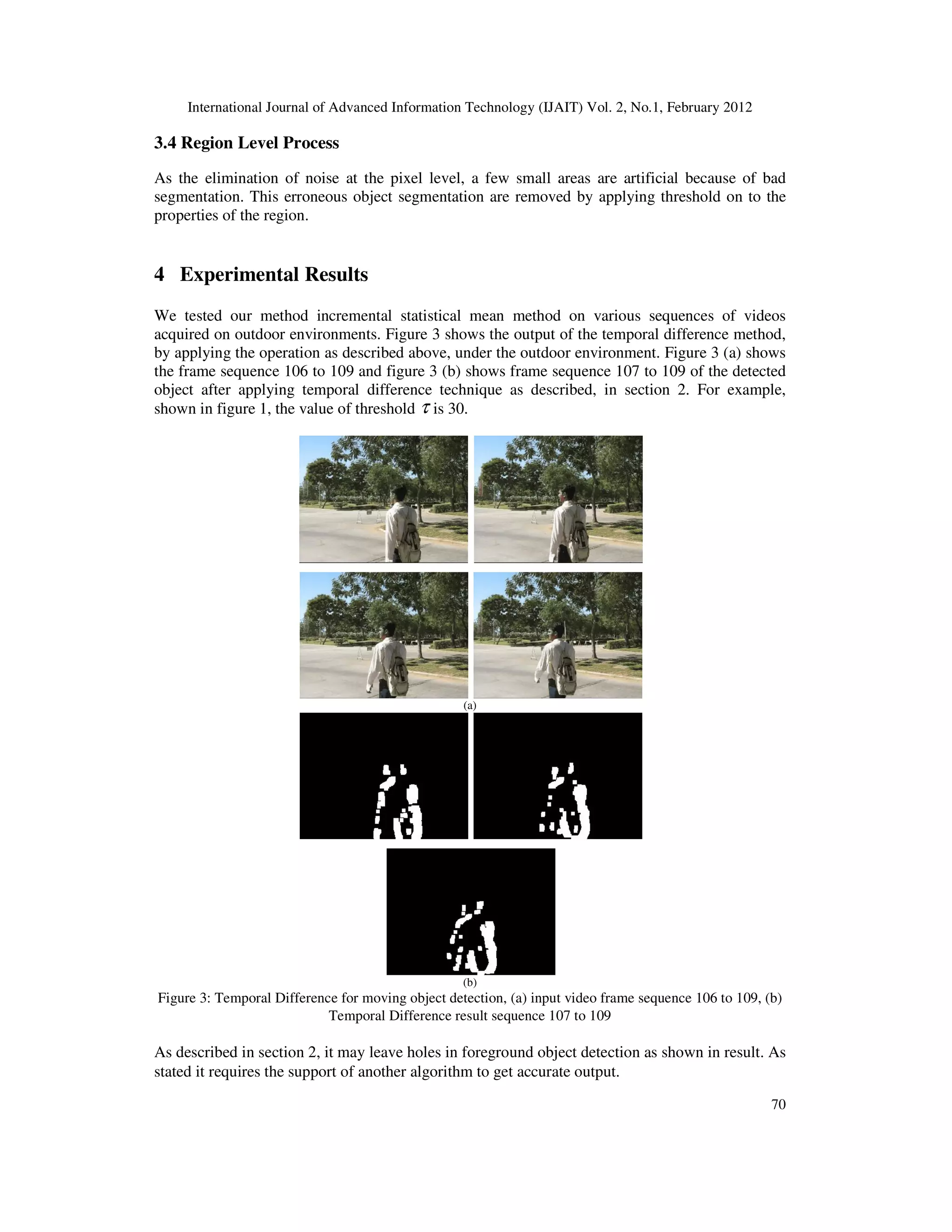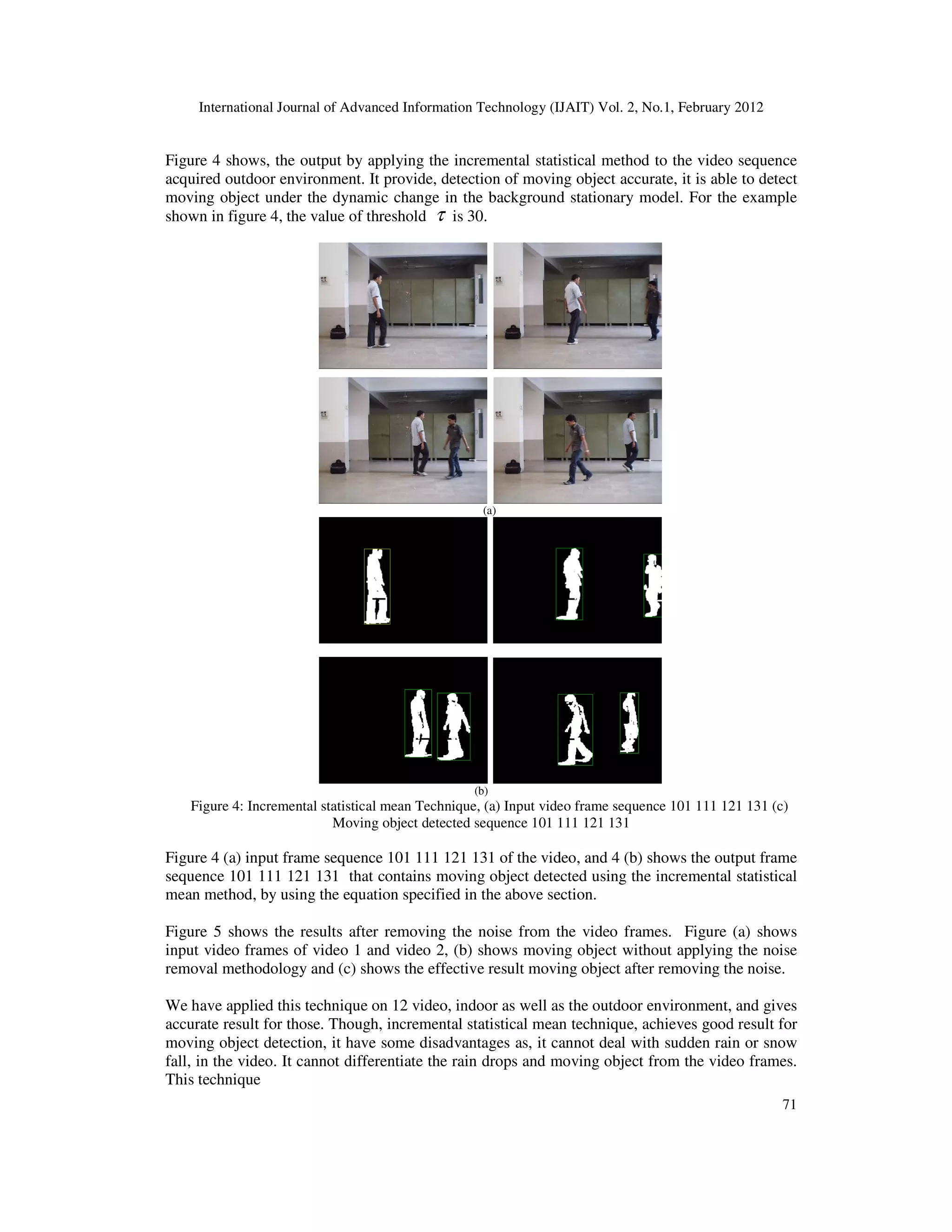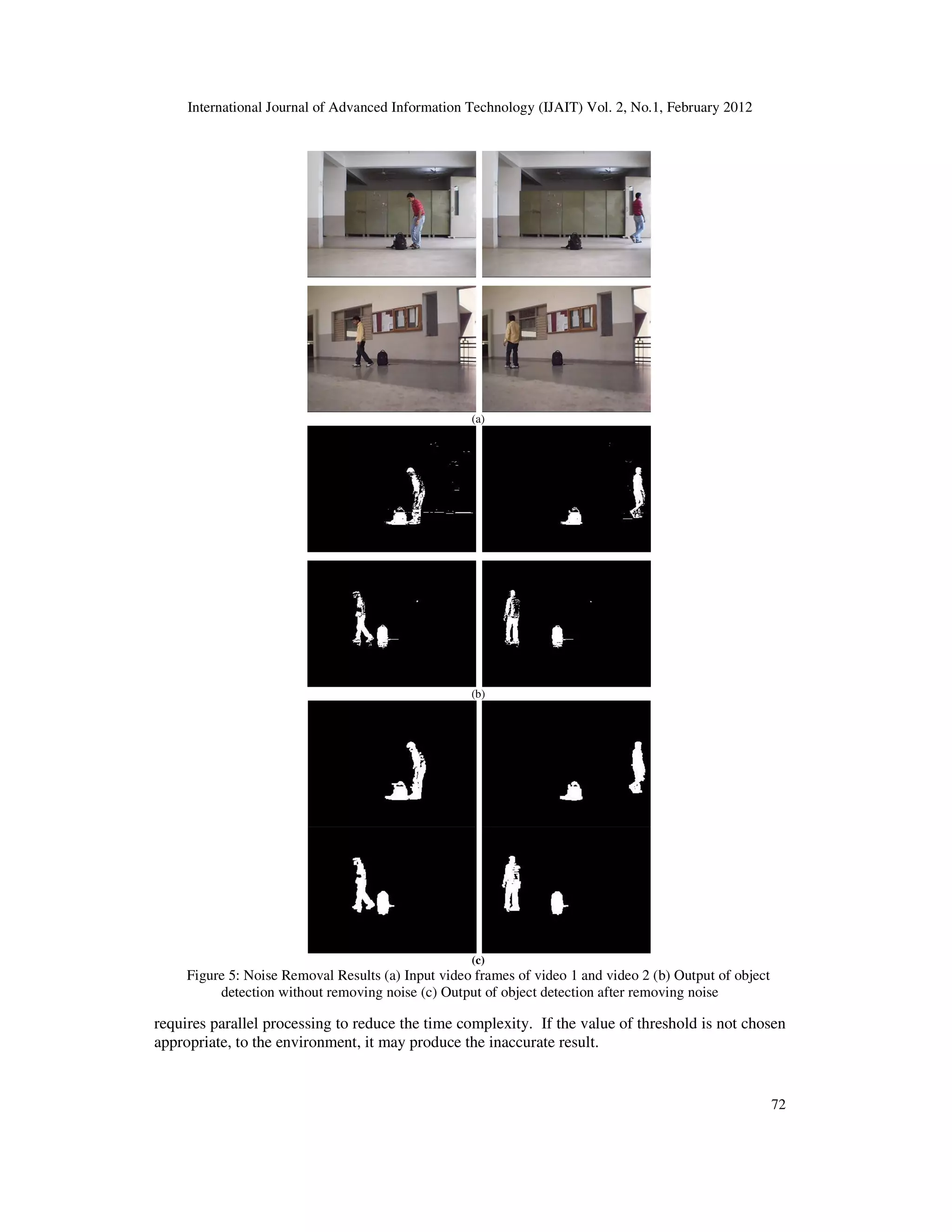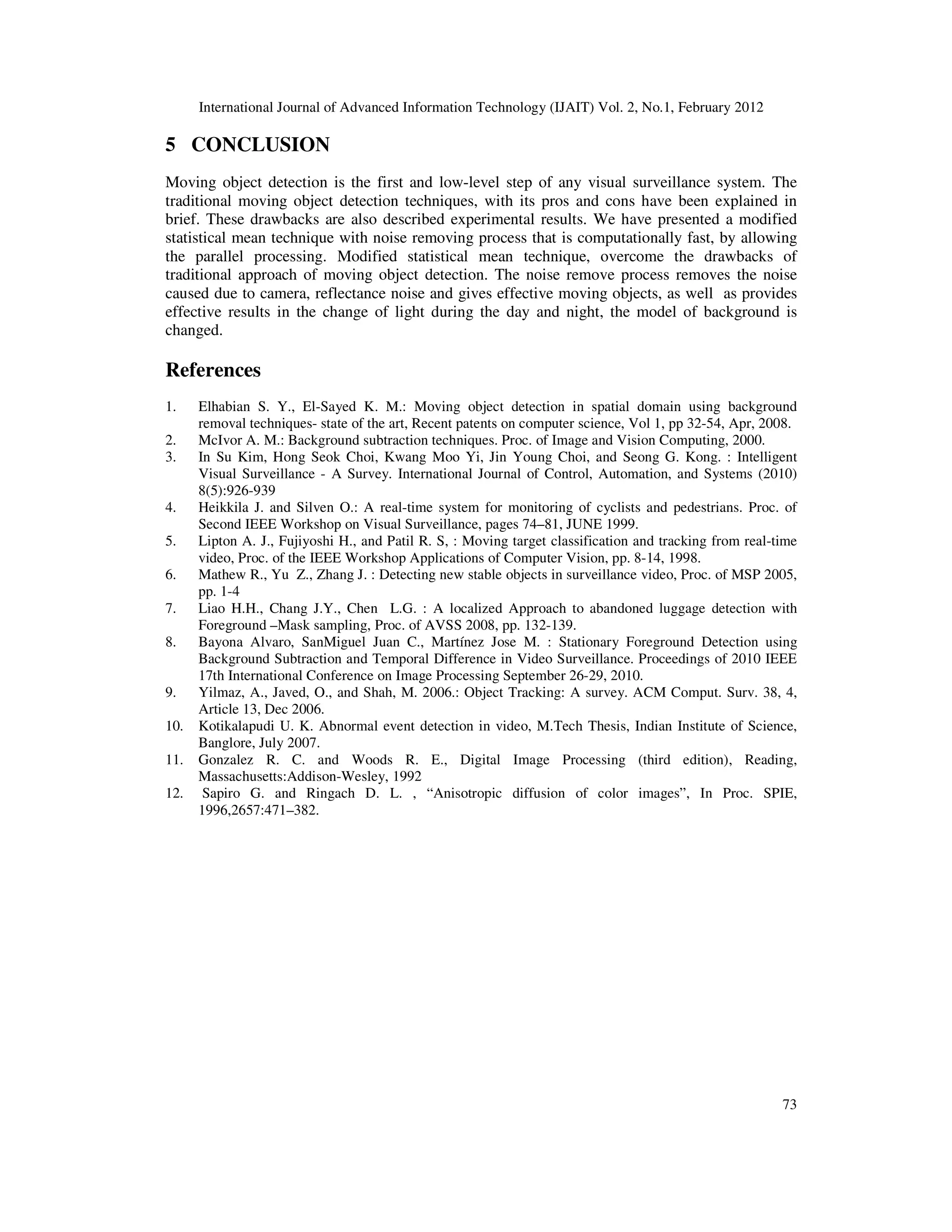This document presents a modified statistical mean technique for improving moving object detection in video surveillance systems, addressing issues like noise and computational complexity inherent in traditional methods. The proposed approach includes various steps such as pixel-level processing and noise removal to enhance detection robustness and accuracy. Results from experiments illustrate the effectiveness of this method in accurately detecting moving objects under dynamic conditions.
![International Journal of Advanced Information Technology (IJAIT) Vol. 2, No.1, February 2012 DOI : 10.5121/ijait.2012.2106 65 A Robust Method for Moving Object Detection Using Modified Statistical Mean Method Safvan Vahora1 , Narendra Chauhan 2 , and Nilesh Prajapati 3 1 Dept. of Information Technology, Vishvakarma Government Engineering College, Ahmedabad, India 2 Dept. of Information Technology, A. D. Patel Institute of Technology, Anand, India 3 Dept. of Information Technology, Birla Vishvakarma Mahavidyalaya, Anand, India {safvan465 ,narendracchauhan}@gmail.com, nilesh.prajapati@bvmengineering.ac.in Abstract. Moving object detection is low-level, important task for any visual surveillance system. One of the aim of this paper is to, to describe various approaches of moving object detection such as background subtraction, temporal difference, as well as pros and cons of these techniques. A statistical mean technique [10] has been used to overcome the problem in previous techniques. Even statistical mean method also suffers with the problem of superfluous effects of foreground objects. In this paper, the presented method tries to overcome this effect as well as reduces the computational complexity up to some extent. In this paper, a robust algorithm for automatic, noise detection and removal from moving objects in video sequences is presented. The algorithm considers static camera parameters. Keywords: Moving object detection, Noise detection and removal, Statistical mean technique. 1 Introduction Computer vision system have been developed, in order to simulate the most natural systems which have ability to deal with changing environments such as moving objects, objects tracking, changing illumination, and changing view point. In video surveillance system, detection and tracking of object is lower level task that provides support to higher level tasks such as event detection. Categorizing moving objects is a critical task which requires video segmentation, which is used in number of computer vision applications such as video surveillance, traffic monitoring, and remote sensing [1]. There are three major steps in video surveillance analysis: detection of moving objects, tracking of interested objects from consecutive frames, and the third is analysis of these tracked objects to identify its behavior, and also to identify normal/abnormal events. There are many applications those uses video surveillance. Video traffic monitoring is gathering traffic information from various visual sources to redirect the traffic flow. Smart video surveillance system is monitoring scene continuously, to detect a desired event. Gesture recognition is to identify human gesture, fingerprint detection and eyes detection to login into a system. Video indexing can be used for automatically explanation and retrieval of videos in multimedia database.](https://image.slidesharecdn.com/2112ijait06-191024062810/75/A-Robust-Method-for-Moving-Object-Detection-Using-Modified-Statistical-Mean-Method-1-2048.jpg)
![International Journal of Advanced Information Technology (IJAIT) Vol. 2, No.1, February 2012 66 Moving object detection process of classifying the pixels in video frames into the two classes, foreground pixels are considered as pixels of moving object and background pixels are considered as pixels of stationary background object. In another words, moving object detection handles segmentation of from stationary background object. Detection of moving object can be complex due to several reasons such as noise in video sequence, sudden illumination changes, shadows and waving tree branches in the wind, rain or snow-fall for outdoor video surveillance, occlusion provide loss of information by projection of 3D world in 2D image [9]. Different approaches have been proposed by different researchers for moving object detection. In this paper, a modified statistical mean technique has been presented for moving object detection, that having various advantages over the traditional approaches of moving object detection. The presented method tries to reduce the effect of noise found during the detection of moving objects. Hence it increases the robustness in detection process. Figure 1 shows the framework of presented robust approach for moving object detection by noise detection and removal. We describe each phase in subsequent section. Figure 1: Framework of Noise Robust detection of moving object The rest of the paper is organized as follows. In section 2, we give details of traditional background subtraction technique, temporal difference and statistical mean technique of moving object detection. In section 3, we describe a robust method for noise detection and removal during the detection of moving objects. This has been achieved by using modification to statistical mean technique which is the modified version of statistical mean technique as described in section 2. Experimental results and conclusion are described in section 4 and section 5 respectively. 2 Methods for Moving Object Detection 2.1 Background Subtraction Object detection [3, 6, 7, 8, 10] can be achieved by creating background model and then finding deviations from the model for each and every frame in video. Background subtraction is widely used because of its time complexity less for detecting the foreground object. Background subtraction is particularly a for motion segmentation in static scenes [2]. Background subtraction is most popular choice to detect stationary foreground objects [6, 7], because they work well when the camera is static and illumination change is gradual [8]. In this method, to detect the foreground object, the background subtraction algorithm detects the difference between the current image and the background image or often called reference image or background model. Recent background subtraction algorithms focused on robust background modeling and updating to adapt to varying illumination condition between night and day, light effects, background structures, background change from whether change and repetitive motion from clutter [3]. For a pixel location (x, y) in the current image I, is identified as foreground pixel along with background image B, if it satisfies the equation 1.](https://image.slidesharecdn.com/2112ijait06-191024062810/75/A-Robust-Method-for-Moving-Object-Detection-Using-Modified-Statistical-Mean-Method-2-2048.jpg)
![International Journal of Advanced Information Technology (IJAIT) Vol. 2, No.1, February 2012 67 τ>− |),(),(| yxByxI (1) whereτ is a predefined threshold [4]. The background image B is updated by the adaption coefficient η as per the equation 2. iii BIB )1(1 ηη −+=+ (2) The core part of this method is to integrate the new upcoming information of a new image into the background image, so that background image becomes more robust. The value of η should not be large, it may create faster new changes in the background image. The pixels constituting the regions undergoing change are marked for further processing. In general, a connected component algorithm is used to obtain connected regions corresponding to the objects. Even though the background subtraction technique is well to extract moving object, this background subtraction technique may suffer to dynamic background changes such as the entrance of new background object or sudden illumination change. 2.2 Temporal Differencing Temporal differencing technique uses the pixel wise difference between two or three frames in frame sequences to extract a moving object. [5, 10] Temporal differencing technique is computationally simple and fast as well as is adaptive to dynamic environment. In temporal difference technique, extraction of moving pixel is simple and fast. It takes difference of the current and previous frames as shown in equation 3 τ>− − |),(),(| 1 yxIyxI ii (3) whereτ is predefined threshold. Temporal differencing technique is less effective in extracting all information about target object, especially when the target object has uniform texture or target object moves slowly. When a foreground object moves slowly or stops moving in between, temporal difference technique fails in detection a change between consecutive frames and loses the target object information. Temporal difference is most sensitive to the threshold valueτ , to determining pixel-wise difference between consecutive frames as well as it may left holes in foreground objects. Temporal difference require special supportive algorithm to detect stopped objects. 2.3 Statistical Mean Technique There are some drawbacks of traditional moving object detection approach, as described in the above section. To overcome these shortcomings, we propose the next technique is statistical mean technique. Statistical mean technique [10] is based on the computed statistics of each and every frame of video or computed statistics of every k frames by using down sampling to reduce the processing time. In statistical mean technique base, background image is calculated by computing mean of each and every pixel available in video. For n frames and (x, y) is the pixel position of Ith frame, the summation of all frames computed as shown equation 4](https://image.slidesharecdn.com/2112ijait06-191024062810/75/A-Robust-Method-for-Moving-Object-Detection-Using-Modified-Statistical-Mean-Method-3-2048.jpg)
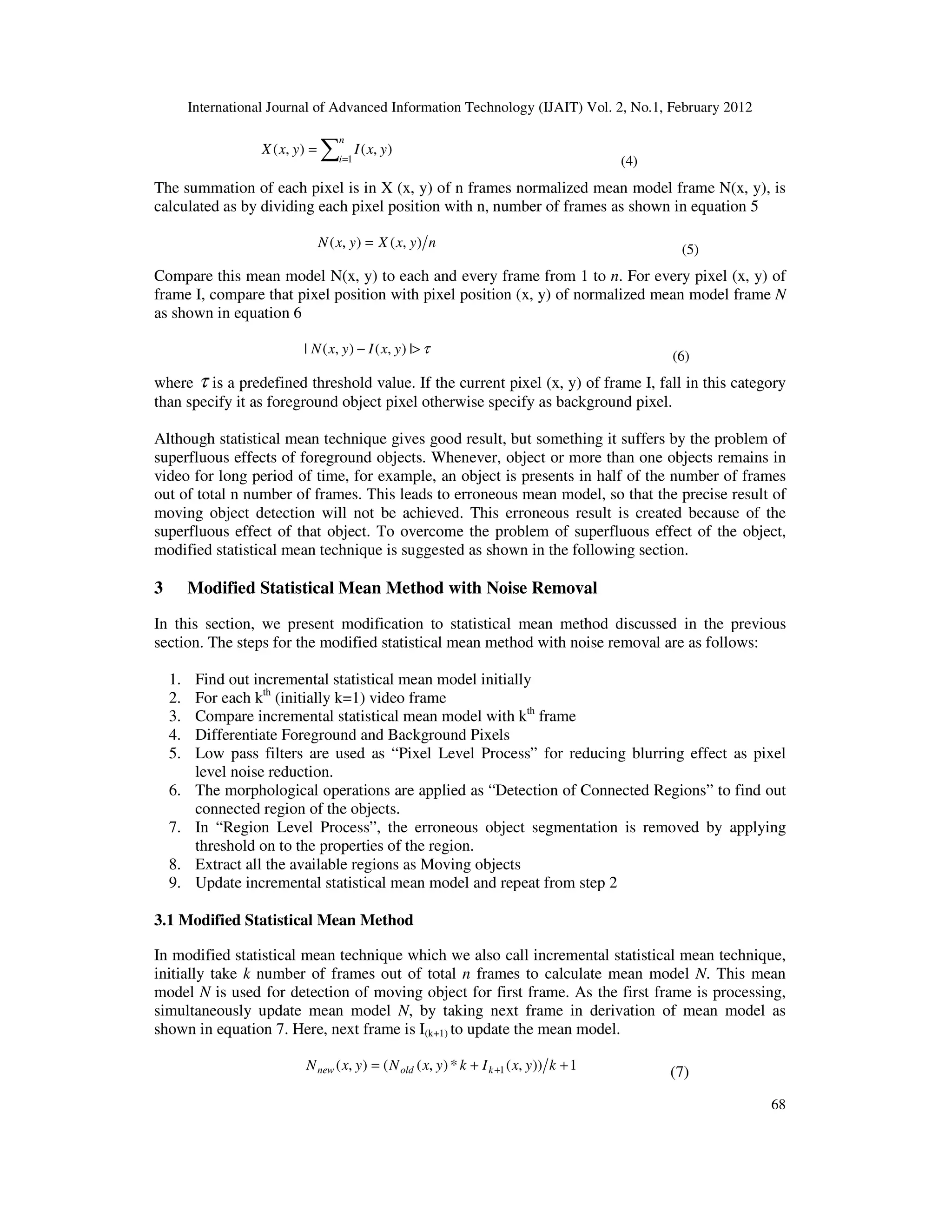
![International Journal of Advanced Information Technology (IJAIT) Vol. 2, No.1, February 2012 This updated mean model Nnew detection. This process is repeated until it reaches to n, total number of frames. 3.2 Pixel level Processing The methods discussed above are generally not sufficient to get desired moving object detection output. Generally, it affects by various noise factors. To overcome this dilemma of noise, it requires further pixel level processing. We use low-pass filter for the pixel map that leads to implementation of these operations is the removal of noise pixels in the foreground that does not correspond to regions leading real and remove noisy pixels nea covered by the pixels which is first plane background. A Gaussian filter smoothing an image by calculating a weighted average filter coefficient Gaussian filter modifies the input signal by convolution with a Gaussian dimensions, Gaussian filter is the product of two such Gaussians, one per direction as described in equation 8 (g where, x is the distance from the origin in the horizontal axis, y is the distance from the the vertical axis standard deviation of the Gaussian distribution. response of the 2D Gaussian filter Figure 2: Our aim in applying these operations is removing noisy to actual foreground regions, and to remove the noisy background pixels near and inside object regions that are actually foreground pixels. 3.3 Finding Connected Regions In this phase the filtered foreground pixels erosion dilation morphological operations are applied Advanced Information Technology (IJAIT) Vol. 2, No.1, February 2012 new is used to for further processing to find the moving object detection. This process is repeated until it reaches to n, total number of frames. The methods discussed above are generally not sufficient to get desired moving object detection output. Generally, it affects by various noise factors. To overcome this dilemma of noise, it requires further pixel level processing. pass filter for the pixel map that leads to eliminate noise[11].Our objective in the implementation of these operations is the removal of noise pixels in the foreground that does not correspond to regions leading real and remove noisy pixels near the bottom and in the regions covered by the pixels which is first plane background. A Gaussian filter smoothing an image by calculating a weighted average filter coefficient Gaussian filter modifies the input signal by convolution with a Gaussian function. In two dimensions, Gaussian filter is the product of two such Gaussians, one per direction as described ( ) e yx yx + − ∏ = 2 2 2 2 2 1 , σ σ (8) where, x is the distance from the origin in the horizontal axis, y is the distance from the the vertical axis standard deviation of the Gaussian distribution. Fig. 2 shows the frequency response of the 2D Gaussian filter Frequency response of the 2D Gaussian filter Our aim in applying these operations is removing noisy foreground pixels that do not correspond to actual foreground regions, and to remove the noisy background pixels near and inside object regions that are actually foreground pixels. Connected Regions he filtered foreground pixels are grouped into connected regions. The subsequent morphological operations are applied to find out connected region of the objects. Advanced Information Technology (IJAIT) Vol. 2, No.1, February 2012 69 is used to for further processing to find the moving object The methods discussed above are generally not sufficient to get desired moving object detection output. Generally, it affects by various noise factors. To overcome this dilemma of noise, it 11].Our objective in the implementation of these operations is the removal of noise pixels in the foreground that does not r the bottom and in the regions A Gaussian filter smoothing an image by calculating a weighted average filter coefficient[12]. function. In two dimensions, Gaussian filter is the product of two such Gaussians, one per direction as described where, x is the distance from the origin in the horizontal axis, y is the distance from the origin in shows the frequency foreground pixels that do not correspond to actual foreground regions, and to remove the noisy background pixels near and inside object The subsequent to find out connected region of the objects.](https://image.slidesharecdn.com/2112ijait06-191024062810/75/A-Robust-Method-for-Moving-Object-Detection-Using-Modified-Statistical-Mean-Method-5-2048.jpg)
